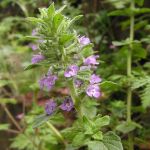| Common Name: |
Basil thyme |
| Botanical Name: |
Acinos arvensis syn A. thymoides, Clinopodium acinos, Satureja acinos |
| Genus: |
Acinos |
| Family: |
Lamiaceae |
| Native Location: |
N Europe, the Mediterranean, and W Asia |
| Cultivation: |
Light dry soil in sun. Prefers sandy and alkaline conditions. |
| Propagation: |
By seed sown in summer in sandy mix. Self-seeds in suitable sites. |
| Harvest: |
Flowering plants are cut in summer when in flower and used fresh in infusions, or as a salad herb. |
| Height: |
15-20cm (6-8in) |
| Width: |
20-30cm (8-12in) |
| Hardiness: |
Z7-8 |
| Parts Used: |
Whole plant, oil |
| Properties: |
A stimulant, diuretic herb that benefits the digestive system and irritates the tissues, causing a temporary improvement in loval blood supply. |
| Medicinal Uses: |
Internally, according to old herbals, for shortness of breath, melancholy, and improving the digestion. Externally, oil was once distilled to treat bruises, toothache, sciatica, and neuralgia. |
| Culinary Uses: |
Once used to flavor jugged hare in England. |
| Bibliography: |
Encyclopedia of Herbs by Deni Brown Copyright © 1995, 2001 Dorling Kindersley Limited. Pg 100 |

